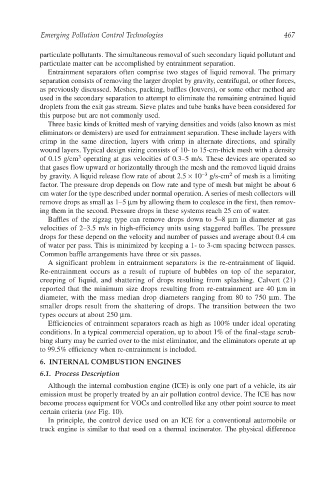Page 495 - Air Pollution Control Engineering
P. 495
12_ch_wang.qxd 05/05/2004 5:26 pm Page 467
Emerging Pollution Control Technologies 467
particulate pollutants. The simultaneous removal of such secondary liquid pollutant and
particulate matter can be accomplished by entrainment separation.
Entrainment separators often comprise two stages of liquid removal. The primary
separation consists of removing the larger droplet by gravity, centrifugal, or other forces,
as previously discussed. Meshes, packing, baffles (louvers), or some other method are
used in the secondary separation to attempt to eliminate the remaining entrained liquid
droplets from the exit gas stream. Sieve plates and tube banks have been considered for
this purpose but are not commonly used.
Three basic kinds of knitted mesh of varying densities and voids (also known as mist
eliminators or demisters) are used for entrainment separation. These include layers with
crimp in the same direction, layers with crimp in alternate directions, and spirally
wound layers. Typical design sizing consists of 10- to 15-cm-thick mesh with a density
3
of 0.15 g/cm operating at gas velocities of 0.3–5 m/s. These devices are operated so
that gases flow upward or horizontally through the mesh and the removed liquid drains
2
by gravity. A liquid release flow rate of about 2.5 × 10 −3 g/s-cm of mesh is a limiting
factor. The pressure drop depends on flow rate and type of mesh but might be about 6
cm water for the type described under normal operation. A series of mesh collectors will
remove drops as small as 1–5 µm by allowing them to coalesce in the first, then remov-
ing them in the second. Pressure drops in these systems reach 25 cm of water.
Baffles of the zigzag type can remove drops down to 5–8 µm in diameter at gas
velocities of 2–3.5 m/s in high-efficiency units using staggered baffles. The pressure
drops for these depend on the velocity and number of passes and average about 0.4 cm
of water per pass. This is minimized by keeping a 1- to 3-cm spacing between passes.
Common baffle arrangements have three or six passes.
A significant problem in entrainment separators is the re-entrainment of liquid.
Re-entrainment occurs as a result of rupture of bubbles on top of the separator,
creeping of liquid, and shattering of drops resulting from splashing. Calvert (21)
reported that the minimum size drops resulting from re-entrainment are 40 µm in
diameter, with the mass median drop diameters ranging from 80 to 750 µm. The
smaller drops result from the shattering of drops. The transition between the two
types occurs at about 250 µm.
Efficiencies of entrainment separators reach as high as 100% under ideal operating
conditions. In a typical commercial operation, up to about 1% of the final-stage scrub-
bing slurry may be carried over to the mist eliminator, and the eliminators operate at up
to 99.5% efficiency when re-entrainment is included.
6. INTERNAL COMBUSTION ENGINES
6.1. Process Description
Although the internal combustion engine (ICE) is only one part of a vehicle, its air
emission must be properly treated by an air pollution control device. The ICE has now
become process equipment for VOCs and controlled like any other point source to meet
certain criteria (see Fig. 10).
In principle, the control device used on an ICE for a conventional automobile or
truck engine is similar to that used on a thermal incinerator. The physical difference

